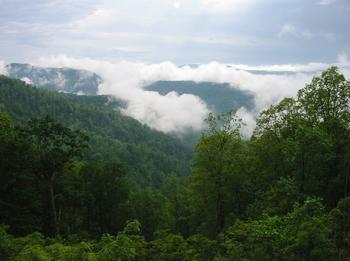Tennessee Governor Petitions to Block Mountaintop Mining
NASHVILLE, Tennessee, October 4, 2010 (ENS) – For the first time a state government has submitted a petition to the federal government to set aside state-owned mountain ridgelines as unsuitable for coal surface mining.
Tennessee Governor Phil Bredesen and the state of Tennessee Friday filed a petition with the Department of Interior’s Office of Surface Mining, asking that the agency initiate a study and public dialogue on the suitability of state-owned lands in the Northern Cumberland Plateau for surface mining, also called mountaintop removal mining.
Much of the 500 miles of ridgeline covered by the petition is part of Tennessee’s 2007 Connecting the Cumberlands conservation initiative and is located in Anderson, Campbell, Morgan and Scott counties.
“These lands are managed by the state of Tennessee for hunting, hiking, wildlife viewing and other outdoor recreational activities,” said Governor Bredesen. “This petition asks the federal government to help us prevent mining on these ridgelines to protect their important cultural, recreational and scientific resources.”
The ridgelines covered in the petition include about 40 percent of the total North Cumberland Wildlife Management Area and Emory River Conservation Easement Tract.
 |
These mountains in the Royal Blue wildlife management area are covered by Tennessee’s petition. (Photo © Melinda Welton courtesy SELC) |
The areas covered by the petition include the Royal Blue, Sundquist and New River units within the North Cumberland Wildlife Management area.
The petition area also includes the Emory River Tract Conservation Easement, which is managed by Frozen Head State Park for public use. A portion of the Cumberland Trail also traverses the area.
Bredesen said, “Surface mining along these mountain ridges would be inconsistent with uses specified in the Wildlife Management Area and Conservation Easement, including hunting and recreation, depriving future generations of these special resources.”
If approved by the Secretary of the Interior, the petition would prevent surface mining of coal for 600 feet on each side of the ridgelines in the designated area, creating a 1,200 foot ridgetop corridor encompassing approximately 67,000 acres.
This area contains most of the older forest that exists in the area as well as an array of habitats and wildlife, some of which are considered rare or threatened.
Upon receiving a complete petition, the federal Office of Surface Mining must prepare an Environmental Impact Statement. This process provides an opportunity for public input prior to a decision being made about whether to accept the Lands Unsuitable for Mining petition under provisions of the Surface Mining Control and Reclamation Act of 1977.
The petition does not affect underground mining or permits for surface mining that have already been issued; nor does it cover any areas in which historical mining has resulted in water pollution from acid mine drainage where re-mining could help improve environmental impacts.
Environmental groups applauded the governor’s move to protect Tennessee ridgelines.
Don Barger, Southeast regional director for the National Parks Conservation Association, said, “The governor’s petition seeks to balance coal extraction with conservation. Clearly in the future we will be burning less coal. This petition requests that the same future includes these ridgelines intact for recreation and tourism they will provide for future generations of Tennesseans.”
Deborah Murray, senior attorney for the Southern Environmental Law Center, said, “This is really good news for Tennesseans and those who enjoy the outstanding natural heritage of this part of the state, and who rely on clean water for their drinking water, fishing, or other uses.”
“Governor Bredesen has consistently demonstrated his commitment to protecting Tennessee’s environment,” Murray said. “We strongly support his action today to protect the ridgelines and put these public lands off-limits to destructive mining practices such as mountaintop removal mining.”
Much of the land covered in the petition is upstream from the Big South Fork National River and Recreation Area. The environmental groups say surface coal mining in this area threatens aquatic life, including more than 13 federally threatened or endangered aquatic species found in the Big South Fork River.
Pollution from resource extraction, including expanding surface coal mining, is impacting water quality in the park, the groups warn.
The federally managed Big South Fork area and connected state lands offer camping, whitewater rafting, kayaking, canoeing, hiking, horseback riding, mountain biking, hunting and fishing.
In a 2005 report by the National Park Service, these recreational activities represented a $10 to $16 million economic benefit annually to the region.
The North Cumberlands petition is similar to a Lands Unsuitable for Mining petition granted in 2000 that covers Fall Creek Falls State Park and the watersheds that flow into it.
In 1990, the Office of Surface Mining designated the Flat Fork watershed adjacent to Frozen Head State Park as unsuitable for mining, in part to protect the unique resources of the park.
Copyright Environment News Service (ENS) 2010. All rights reserved.
